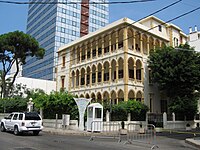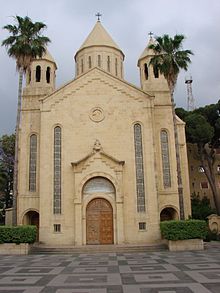From Wikipedia, the free encyclopedia
The
Armenians in Lebanon (
Armenian:
Լիբանանահայեր,
Arabic:
أرمن لبنان) are
Lebanese citizens of
Armenian descent. There has been an Armenian presence in
Lebanon for centuries. While there has not been a census for a few decades, because the balance between
Christians and
Muslims is considered to be a volatile subject, it is estimated that there are approximately 150,000 Armenians in Lebanon, or around 4% of the population. Prior to the
Lebanese Civil War, the number was higher, but the community lost a portion of its population to emigration.
[edit] History
Armenians first established contact with Lebanon when
Tigranes the Great conquered
Phoenicia from the
Seleucids and made it part of his short lived Armenian Empire. When the
Roman Empire established its rule over both Armenia and ancient Lebanon, some Roman troops of Armenian origin went there in order to accomplish their duties as Romans. After Armenia converted to Christianity in 301, Armenian pilgrims established contact with Lebanon and its people on their way to
Jerusalem; some of whom even settled there.
[edit] Armenians in Lebanon (1915 - 1975)

Camp of Armenian exiles in Beirut
The Armenian presence in Lebanon during the
Ottoman period was minimal, however, there was a large influx of Armenians after the
Armenian Genocide of 1915.
When Armenians first came to Lebanon they inhabited the area of
Karantina. Later on, in
Bourj Hammoud, a thriving Armenian community was formed.
In 1939, after the
French ceded the
Syrian territory of
Alexandretta to
Kemalist Turkey, Armenians, other
Christians and
Arabs from the area moved to the
Bekaa Valley. The Armenians were grouped in
Anjar, where a community exists to this day.
[edit] Armenians in Lebanon (1975 - Present)

Around 10 000 Lebanese-Armenians marching on April 24, 2006, on the 91st anniversary of the
Armenian GenocideDuring the Lebanese Civil War, Armenians, grouped in Bourj Hammoud and Anjar, did their best to remain neutral. There are three prominent Armenian political parties in Lebanon: the
Armenian Revolutionary Federation (Tashnag),
Social Democrat Hunchakian Party (Hunchag) and
Armenian Democratic Liberal Party (Ramgavar Party). They play significant influence in all facets of Armenian life. Various Armenian terrorist organizations, such as
ASALA,
JCAG and
ARA became active in Lebanon, and used it as a launching pad for their operations.
Put forth by the Armenian bloc of the
Lebanese Parliament, the legislature unanimously approved on April 4, 1997 a resolution, calling for the commemoration of the 82nd anniversary of the Armenian Genocide perpetrated by the Ottoman Turkish government.
[1]
After the
2006 Israel-Lebanon conflict, Turkey proposed to send some of its troops to Lebanon as a part of
UNIFIL. Most Armenians strongly oppose Turkish involvement.
[edit] Demographics
Armenians live in many areas of Lebanon. Most Armenians live in Beirut and
Matn District. From Beirut proper we can mention Achrafieh, Medawwar, Mar Mikhael, Hadjen, Khalil Badawi, Karm el Zeytoun(Հայաշէն), Khandaq Ghamik, Sanayeh (Kantari) and Hamra, among others. During the civil war many of these Armenians emigrated or flee to safer regions in Lebanon.
From the Beirut suburbs, there are big concentrations in Matn District, particularly
Bourj Hammoud, Dora-Amanos, Fanar, Rawda, Jdeide, Zalka, Jal El Dib,
Antelias, Mzher(Dzaghgatzor), Naccash, Dbayeh and in the regions situated from Antelias to Bikfaya.
To the north. there are further Armenian populations scattered in Jounieh, Jbeil (Byblos) and Tripoli (particularly the Mina area).
There are Armenian religious centers in Antelias and Bikfaya (
Armenian Apostolic Church) and Beirut and Bzommar (
Armenian Catholic Church). There is an Armenian orphanage in historic sites in Jbeil (Byblos).
In the Bekaa, there are Armenians living in
Zahlé and most notably
Anjar.
[edit] Bourj Hammoud, an Armenian city in Lebanon
Main article:
Bourj Hammoud (or
Burj Hammud) (
Armenian:
Պուրճ Համուտ,
Arabic:
برج حموﺪ) is a suburb in east
Beirut,
Lebanon in the
Metn district. The suburb is heavily populated by
Armenians as it is where most survivors of the
Armenian Genocide settled. Bourj Hammoud is an industrious area and is one of the most densely-populated cities in the
Middle East. It is divided into seven major regions, namely Dora, Sader, Nahr Beirut, Anbari, Mar Doumet, Naba'a and Gheilan.
Bourj Hamoud has a majority Armenian population but also has a notable number of other Lebanese Christians, a considerable
Shi'a Muslim population and some Palestinian refugees and newcomer Christian refugees from
Iraq.
Most streets in Bourj Hammoud are named after various Armenian cities such as
Yerevan, mountains such as
Aragats, and rivers such as
Araks. A lot of streets are also named after cities and regions in modern-day-
Turkey which were heavily populated by Armenians such as
Cilicia,
Marash,
Sis,
Adana, etc.
[edit] Mezher (Dzaghgatzor), an Armenian town in Lebanon
Mzher (or Dzaghgatzor in Armenian) is a small town located between Antelias and Bssalim, in Matn district. It is a new town, where most of the population is Armenian. In Mzher the Armenian community has one of the top Armenian schools, Arslanian College and a socio-cultural sport club, Aghpalian. Most of the Armenians of Mzher come from Bourj Hamoud, Ashrafieh, Anjar and the other old Armenian quarters.
[edit] Anjar, an Armenian village in Lebanon
Main article:
Anjar, Lebanon (
Arabic:
عنجر,
Armenian:
Անճար), also known as
Haoush Mousa (
Arabic:
حوش موسى), is a town of Lebanon located in the
Bekaa Valley. The population is about 2,400 consisting almost entirely of Armenians.
[edit] Political Representation
According to the traditional Lebanese confessional representation in the Lebanese Parliament, a certain number of seats have been reserved for Armenian candidates according to their confession. Presently the Lebanese-Armenians are represented in the 128-seat Lebanese Parliament with 6 guaranteed seats (5 Armenian Orthodox and 1 Armenian Catholic) as follows:
- 3 Armenian Orthodox seats in the capital Beirut
- 1 Armenian Orthodox seat in the Matn District
- 1 Armenian Orthodox seat in Zahle (Bekaa)
- 1 Armenian Catholic seat in the capital Beirut
Because many Protestants in Lebanon are ethnic Armenians, the sole parliamentary slot for Evangelical (Protestant) community has at times been filled by an Armenian, making for a total of 7 Armenian deputees in the Lebanese Parliament.
Lebanese Armenians have also been represented by at least one government minister in the formations of Lebanese governments. In case of larger governments (with 24 ministers and above) Armenians are traditionally given two Armenian government ministry positions.
The Lebanese-Armenians also have their quota in top-level public positions.
[edit] Education
Lebanon boasts having the only Armenian university in the Armenian Diaspora (outside the Republic of Armenia) called
Haigazian University (HU) one of Beirut's most prestigious academic institutions. Founded in 1955, Haigazian is a liberal arts Armenian institution of higher learning, which uses English as the language of instruction.
Most schools are run by church organizations of the three Armenian Christian denominations (Orthodox, Catholic and Evangelical). Others are run by cultural associations like Hamazkayin and Armenian General Benevolent Union (AGBU)
Some long-running Armenian secondary schools and colleges to mention:
Lebanese Armenians have developed an active interest in developing media outlets. Lebanese Armenians were keen in establishing dailies since the 1920s when they established in great numbers in Lebanon. "Pyunik" was the pioneer newspaper establishing (replaced by Aztag in 1927).
There are three Armenian daily newspapers published in Beirut all mouthpieces of the traditional Armenian political parties (Tashnag, Hunchag and Ramgavar).
From the defunct Armenian political newspapers besides "Pyunik" in the 1920s, one should mention the independent non-partisan newspaper "Ayk" (after decades of publishing in Armenian, the licence owner Lucie Tosbat sold it to "Monday Morning" Publishing Group and "Ayk" started publishing as an English-language daily renamed "Ike" before folding.) "Ayk" daily's Lebanese-Armenian publishers Dikran and Lucie Tosbat also published the French language "Le Soir".
Special mention should also be made for the Armenian leftist daily newspaper "Joghovourti Tsayn" (meaning Voice of the People).
Lebanon has kept throughout a strong tradition in periodicals and weekly newspapers in the Armenian language, so obviously it is impossible to cover all. But from the notable long-running publications, special mention could be made for:
- "Hasg", official publication of the Catholicosate of the Great House of Cilicia (Armenian Apostolic)
- "Avedik", official publication of the Armenian Catholic Church
- "Yeridasart Hayouhi" (literary periodical dedicated to women) which was later turned into an independent political biweekly called "Yeridasart Hay".
- "Nor Gyank" (New Life) the lifestyle newspaper/magazine
- "Gantch", the Armenian Communist weekly (part of Arabic language communist "An Nidaa")
- "Khosnag" the Armenian General Benevolent Union (AGBU) official publication
- "Pakin" literary cultural publication
- "Shirak" literary cultural publication
- "Nayiri" literary publication
- "Spurk" literary and cultural publication
- "Massis" Armenian Catholic publication
- "Badanegan Artsakank" Armenian Evangelical / Youth publication
- "Marzig" Homenetmen's sports monthly
- "Tidag" social lifestyle magazine
- "Hasg Hayakidagan Hantes", an annual Armenological publication by the Holy See of Cilicia
- "Haigazian Armenological Review", an annual Armenological publication of Haigazian University
The Lebanese state radio established very early on daily radio broadcasts in Armenian through its second channel consecrated to broadcasting in languages (mainly French and English). That programming goes on to date on Radio Liban.
During the civil war, the Lebanese Armenians established a great number of unlicenced radio stations (some non-stop for 24 hours a day). The pioneer was the popular radio station "Radio Paradise" and later on "Vana Tsayn" (Voice of Van). However with the Lebanese Parliament enacting laws organizing the airwaves, all the unlicenced stations (alongside the other Lebanese stations) had to close.
They were replaced by two operating and fully licenced radio stations operating in Armenian in Lebanon in accordance with the new broadcast laws - "Voice of Van" and "Radio Sevan".
[edit] Television
Lebanese private stations and state-owned Tele-Liban have consecrated occasionally television programming in Armenian on certain occasions.
During the Lebanese civil war, an Armenian television station "Paradise Television" co-operated with "Radio Paradise" was established through a broadcast tower in Bourj Hammoud. But "Paradise Television" Armenian television station had to close after it failed to get a broadcasting licence according to the new laws organizing the airwaves.
However very notably, Al Mustaqbal Television (also known as
Future Television) and OTV broadcast daily news and comments in Armenian in their regular programming.
[edit] Religion
Officially, there are 3 Armenian denominations recognized by the government. The Armenians have Armenian Orthodox, Armenian Catholic, or Armenian Evangelical mentioned in their identity cards, in the denomination field.
However sometimes there are variations particularly in case of the Armenian Evangelicals, sometimes registered as just Evangelicals or Protestants without mention of Armenian. There are also some Armenian Catholics who are registered under the denomination Latin, sometimes Armenian Latin.
[edit] Apostolic (Orthodox) Armenians
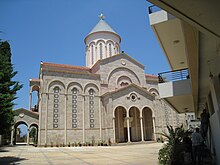
Holy Cross Church (Sourp Nshan) in downtown Beirut, in front of the
Grand Serail 
Holy Mother of God Church (Sourp Asdvadzadzin) at the Armenian Seminary in Bikfaya
The
Holy See of Cilicia is located in
Antelias (a northern suburb of Beirut). It was relocated there in 1930 from Sis (historical Cilicia, now in Turkey) after the
Armenian Genocide. Alongside the Mother See of Holy
Echmiadzin located in Republic of
Armenia, it is one of the two sees of the
Armenian Apostolic Church (the national church of Armenians).
The Catholicos, the leader of the Holy See of Cilicia, has his summer residence in
Bikfaya in the
Matn District also north of Beirut. The seminary of the Armenian Apostolic Church is also on site at Bikfaya.
The affairs of the Lebanese Armenian Orthodox population however are run by an independent body, the
Armenian Prelacy of Lebanon (Aratchnortaran Hayots Lipanani) with its own Armenian Primate of Lebanon Archbishop Kegham Khatcherian as head.
The Armenian Apostolic churches in Lebanon include:
- The Saint Gregory the Illuminator Mother Cathedral (Sourp Krikor Lousavoritch Mayr Dajar ) which serves as the church for the Holy See of Cilicia (Catholicossate of the Great House of Cilicia - In Armenian "Gatoghigosaran Medzi Danen Guiligio" (Antelias, Lebanon). The big complex also contains a memorial chapel dedicated to the victims of the Armenian Genocide, an Armenian library, printing presses, Armenian museum and "Veharan", residence of the catholicos of Cilicia and premises for the clergy.
- Holy Cross (Saint Neshan) Armenian Orthodox Church (Downtown Beirut) which serves as the church for the Armenian Apostolic Archbishopric of Lebanon and head office of the Armenian Primate of Lebanon.
- Saint Hagop Armenian Apostolic Church (Jetawi, Achrafieh, Beirut)
- Saint George (Sourp Kevork) Armenian Apostolic Church (Hadjin, Mar Mikhael, Beirut)
- Armenian Apostolic Church of the Assumption (Khalil Badaoui, Beirut)
- Armenian Apostolic Church of the Assumption (Jounieh, Kesrouan, Lebanon)
- Forty Martyrs (Karasoun Manoug) Armenian Apostolic Church (Marash, Bourj Hammoud)
- Holy Mother of God (Sourp Asdvadzadzin) Armenian Apostolic Church (Adana, Bourj Hammoud)
- Saint Vartan Armenian Apostolic Church (Tiro, Bourj Hammoud)
- Saint Sarkis Armenian Apostolic Church (Sis, Bourj Hammoud)
- Saint Paul (Sourp Boghos) Armenian Apostolic Church (Anjar, Bekaa)
- Holy Pentecost Armenian Apostolic Church (Tripoli, North Lebanon)
- Holy Mother of God (Sourp Asdvadzadzin) Armenian Apostolic Church - a complex that also includes the Zarehian Tebrevank (both in Bickfaya, Metn) and the commemorative statue of the Armenian Genocide
[edit] Catholic Armenians
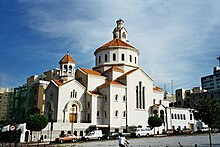
St. Gregory the Illuminator - St. Elie Armenian Catholic Church (1909), Debbas Square, downtown Beirut
, has its patriarchate in the Lebanese capital
Beirut, and represents Armenian Catholics around the world. Armenian Catholic Church also has its summer residence and its convent in
Bzoummar, Lebanon, north of Beirut.
The Armenian Catholic churches include:
- St. Elie-St. Gregory the Illuminator (Sourp Yeghia - Sourp Krikor Lousavoritch Armenian Catholic Cathedral, (Debbas Square, Downtown Beirut)
- Armenian Catholic Church of the Annunciation (Achrafieh, Jetawi, Beirut) - also serving as church for the Armenian Catholic Patriarchal Eparchy.
- Armenian Catholic Church and the Convent of Bzoummar (Bzommar, Lebanon)
- St. Saviour (Sourp Pergitch) Armenian Catholic Church (Bourj Hammoud)
- Holy Cross (Sourp Khatch) Armenian Catholic Church (Zalka)
- Our Lady of Fatima Armenian Catholic Church (Hoch el Zaraani, Zahle, Beqaa)
- Our Lady of the Rosary Armenian Catholic Church (Ainjar, Beqaa)
[edit] Evangelical Armenians
Armenian Evangelical Church, headquartered in
Ashrafieh. The affairs of the Lebanese Evangelical community is run by the Union of the
Union of the Armenian Evangelical Churches in the Near East (UAECNE).
Majour Armenian Evangelical Churches:
- First Armenian Evangelical Church (Kantari, Beirut)
- Armenian Evangelical Church (Achrafieh, Beirut)
- Armenian Evangelical Church (Nor Marash, Bourj Hammoud)
- Armenian Evangelical Church (Amanos, Bourj Hammoud)
- Armenian Evangelical Brethren Church (Mar Mikhael, Beirut)
- Armenian Evangelical Church (Anjar, Bekaa)
The churches also have active youth branches called "Tchanits" and summer camps at "Ketchag", near Beirut.
There are also a number of "Brethren" churches of Evangelical orientation ("Yeghpayroutyoun" in
Armenian)
[edit] Monuments
[edit] Armenian Genocide Monument

The Armenian Genocide memorial (1965) in
BikfayaBikfaya is home to a commemorative plaque and monumental sculpture, honoring the victims of the 1915
Armenian Genocide. Designed by Zaven Khedeshian and renovated by Hovsep Khacherian in 1993, the outdoor, freestanding sculpture rests on top of a hill that is located on the grounds of the summer retreat of the Catholicate of Cilicia.
The sculpture is a bronze abstract figure of a woman standing with hands open toward the sky. A plaque with Arabic and Armenian inscriptions reads:
This monument, commemorating the 50th anniversary of the Armenian genocide, was erected with the cooperation of the whole Armenian Community in Lebanon, to celebrate the rebirth of the Armenian nation and to express gratitude to our country, Lebanon - April 24 1969.
The Armenian community of Lebanon visits the monument on April 24 every other year. The pilgrimages are alternated with the memorial chapel at the
Armenian Catholicossate in
Antelias.
[2]
[edit] Sports and Scouts Movements
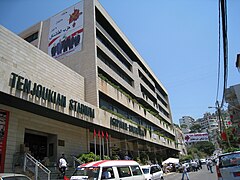
The Homenetmen Aghpalian Club and Tenjoukian Stadium in Antelias
There are three predominantly Armenian sports clubs in Lebanon with a strong tradition in sports as well as Scouting. They are
- Homenetmen Beirut also known as HMEM -- full name Hay Marmnagertagan Enthanour Miyutioun (Armenian General Union of Physical Culture)
- Homenmen Beirut also known as HMM -- full name Hay Marzagan Miyutioun (Armenian Sports Union)
- Antranik Sports Club (of the Armenian Youth Association (AYA) of the Armenian General Benevolent Union AGBU)
All of them have various branches distributed in many Lebanese cities throughout the country where there are Lebanese Armenian communities.
There are also many other smaller local Armenian sports clubs as well in various sports.
[edit] Soccer
The Armenian clubs Homenetmen and Homenmen have important football (soccer) teams in the official first and second division soccer leagues in Lebanon, although the membership of the teams is not restricted to ethnic Armenians and will usually include other Lebanese non-Armenian players as well as contracted foreign players, including professional players from the Republic of Armenia.
Homenetmen Beirut has won the Lebanese Football Championship title 7 times in the years: 1944, 1946, 1948, 1951, 1955, 1963 and 1969 and Homenmen Beirut the Championship title 4 times in 1945, 1954, 1957 and 1961. Overall, both clubs feature in the top 5 of most titles in Lebanese football:
- Al Ansar - 13 titles
- Homenetmen Beirut - 7 titles
- Al Nejmeh Beirut - 6 titles
- Al Nahda - 5 titles
- Homenmen - 4 titles
Many Lebanese Armenians have played for the
Lebanon national football team. From them, we can mention
Mardek Chabarian,
Wartan Ghazarian.
[edit] Basketball
Armenian clubs Antranik and Homenetmen have prominent basketball teams playing in the official first and second division basketball league in Lebanon, although the membership of the teams is mixed and is not restricted to Armenians and will usually include other Lebanese non-Armenian players as well as contracted foreign players.
Many Lebanese Armenians have represented Lebanon in the national team. From them we can mention Vicken Eskedjian and Yervant Avakian. Lebanese national teams have also had coaches and assistant coaches of Armenian origin like Sarkis Kurdjian, Georges Kelzi and Dikran Geokdjian.
In women, the Armenian basketball clubs (Homenetmen and Antranik) are traditionally considered as powerhouses in the sport, and both clubs have won the official Lebanese Basketball Championships women title on several occasions. The Armenian club Antranik's Women Basketball team went on to win the pan-Arab championship titles. Armenian women have had important presence in Lebanese national teams as well, including captain of the team Emma Eskedjian.
For many years, the Lebanese Armenian
Hagop Khajirian (Khatcherian) served as president of
West Asian Basketball Association (WABA), the governing body for basketball for the West Asia region that includes Iran, Iraq, Jordan, Lebanon, Palestine, Syria and Yemen as sanctioned by FIBA and FIBA Asia.
[edit] Other Sports
The abovementioned Lebanese Armenian clubs also have huge influence on many other sports in Lebanon, but most notably in cycling, table tennis (ping pong) and track and fields.
Individual Armenians have also excelled, most notably in weightlifting, wrestling and martial arts competitions.
[edit] Women Sports
Lebanese Armenians also have great influence in women sports in Lebanon, most notably in basketball, cycling and table tennis. The Armenian basketball clubs of Homenetmen and Antranik have won the official Lebanese Basketball Championships on several occasions. The Armenian club Antranik's Women Basketball team went on to win the pan-Arab championship titles.
[edit] Scouting
The Lebanese Armenians also have a strong
Scouting tradition in Lebanon, and many of the Lebanese Armenian sports clubs (AGBU,
Homenetmen, Homenmen) also serve as Scouting organizations as well.
[edit] Notable Lebanese Armenians
Lebanese Armenians have played a major role in Lebanese politics. Lebanon even had its Armenian governors during the Ottoman rule of Lebanon, most notably Daoud Pasha, the Ottoman Armenian governor of Lebanon, as well as for a short period of time Ohannes Pasha Kouyoumdjian – Ottoman Armenian mutasarrif of Lebanon.
Of the deceased politicians, notable mentions would include
Khatchig Babikian, deceased prominent Member of Lebanese Parliament and government Minister on several occasions.
The former President of Lebanon
Émile Lahoud had an Armenian mother and married an Armenian woman, thus making
Renée Lahoud Lebanon's first-ever Lebanese-Armenian First Lady.
FROM WİKİPEDİA


























